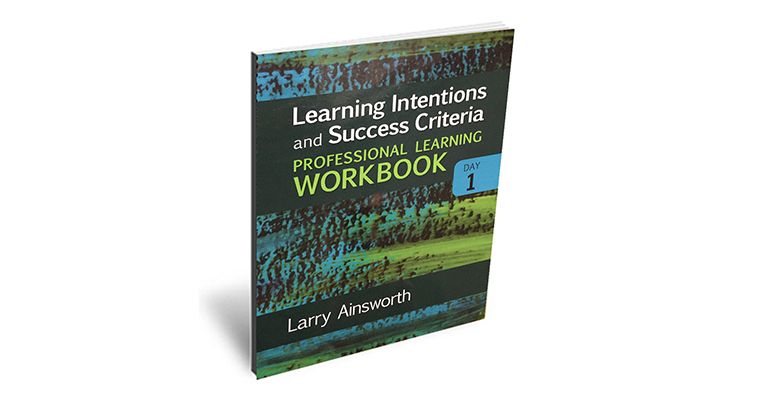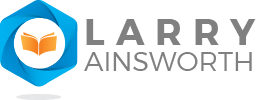TIMELESS PRACTICES TO IMPROVE STUDENT LEARNING
Supporting educators and leaders in their important work of helping every student become a confident and successful learner
Teacher Clarity Learning Intentions and Success Criteria Workshop
TIMELESS PRACTICE #3

BRIEF DESCRIPTION:
Larry's new “Learning Intentions and Success Criteria” workshop is available in both a one-day and two-day format, with the option for additional support days by our team of expert teaching consultants. This highly engaging, hands-on workshop will give educators and leaders a step-by-step, doable process to ensure that teachers are absolutely clear about what their students are to learn, why they are to learn it, and how.
Larry Introduces Teacher Clarity: Learning Intentions and Success Criteria
NEED FOR CLARITY:
We have a clarity problem in our schools! We are not crystal clear about what we want our students to know and be able to do. Without clarity of learning goals that provide the sharp focus for both instruction and assessment, teachers cannot achieve the maximum possible impact on student learning. Without clarity of these learning targets, teachers may unknowingly plan instruction and design assessments that miss the mark. Clarity is essential to writing student-friendly learning intentions and success criteria.
Professor John Hattie’s extensive research revealed this vital statistic: Teacher clarity of learning intentions (what students are to know and be able to do) posts a 0.75 effect size which is equivalent to nearly two years of student growth in one year. (Source: Visible Learning (2009) and Visible Learning for Teachers (2012)
DEFINITIONS?
In Travel Terms:
Learning intentions are what we want students to learn. They represent the “destination” of where we are going.
Success Criteria are the specifics of how students will achieve the learning intentions. They provide the detailed “map” of how we are going.
Learning Progressions are the “building blocks” of instruction needed to achieve the learning intention and success criteria. They provide the “Where to next?” element of the teaching and learning journey. Our team of educational consultants can help fill in the gaps for you with our curriculum and ad-hoc expertise.
ABOUT THE WORKSHOP:
Day 1
During this interactive workshop for all PK-12 educators and leaders, you will learn, through both guided and independent practice, how to:
- Define and describe learning intentions and success criteria using illustrative examples
- Explain the rationale for determining learning intentions and success criteria in advance of instructional planning and assessment design
- Apply the process of creating learning intentions and success criteria to a single standard in focus within a unit of study.
- Decide why a learning intention is important for students to learn (i.e., relevancy; larger connections to school and life).
- Break a learning intention into learning progressions and related success criteria.
Day 2
After completing the initial one-day workshop, you will then have the option to learn, through both guided and independent practice, how to:
- Create learning intentions, success criteria, and learning progressions for multiple standards within a unit of study of your own choosing.
- Create an action plan for introducing learning intentions and success criteria to students, collaborative grade- or course-level teams, school faculty, and/or the entire district.
- Create for students an introductory example that includes: Standard for Instructional Focus, Student-Friendly Learning Intention, Rationale, and Success Criteria.
- Connect learning intentions and success criteria as foundational entry points to other Corwin programs, including: Visible Learning, Common Formative Assessments 2.0, Co-Creating Student Success Criteria, Student Voice, and High-Impact Instruction.
“Production Day” Workshop. After completing the two-day workshop, you can also return for an additional one or more “production days” and work collaboratively with your learning teams to create additional learning intentions, success criteria, and learning progressions for other units of study. A certified Corwin consultant will be on hand to clarify any questions, provide feedback on your work products, and offer any other assistance as needed.
DEFINITIONS
In Travel Terms:
Learning intentions are what we want students to learn. They represent the “destination” of where we are going.
Success Criteria are the specifics of how students will achieve the learning intentions. They provide the detailed “map” of how we are going.
Learning Progressions are the “building blocks” of instruction needed to achieve the learning intention and success criteria. They provide the “Where to next?” element of the teaching and learning journey.
ABOUT THE WORKSHOP:
During this interactive workshop for all PK-12 educators and leaders, you will learn:
- What learning intentions and success criteria are and see illustrative examples across grades and content areas
- How to explain to students why a learning intention is important (i.e., relevancy; larger connections to school and life).
- How to write your own learning intentions and success criteria in advance of instructional planning and assessment design
- How to determine the learning progressions (building blocks of instruction) and success criteria to focus daily instruction
“Production Day” Workshop. After completing the initial workshop, you can schedule an additional one or more “production days” to work collaboratively with your learning teams and create multiple learning intentions, success criteria, and learning progressions for entire units of study. Larry, or one of his associate colleagues, will be on hand to clarify any questions you have, provide feedback on your work products, and offer any other assistance as needed.
WHAT WILL YOU LEAVE WITH?
- A learning intention and its success criteria written in student-friendly wording for a single standard instructional focus of your choice
- Identified reasons why it’s important for students and teachers to achieve this learning intention
- A sequence of learning progressions as “building blocks” to the learning intention
- Specific success criteria matched to selected learning progressions
- A set of tools for use during and after the Day 1 workshop:
- Learning Intentions and Success Criteria Template for a Single Standard
- Worked Examples for Single Standards in Different Content Areas
- Checklist of Success Criteria for Each Step of the Process
- “Build Your Own” Glossary Template
- Next Steps Action Plan
What Will You Leave With on Day 2?
- Fully developed learning intentions and success criteria written in student-friendly wording for multiple standards in your selected unit of study
- Identified reasons why it’s important for students and teachers to achieve these learning intentions
- Set of learning progressions as “building blocks” to the unit standards, sequenced for daily instruction
- Specific success criteria matched to the learning progressions
- Initial draft of action plan for implementing learning intentions and success criteria, specific to students, grade-/course-level teams, school faculty, and/or district
- Introductory example for students including: Standard, Learning Intention, Rationale, Success Criteria
- Additional tools for use during and after the Day 2 workshop:
- Learning Intentions and Success Criteria Template for Multiple Standards
- Worked Examples for Multiple Standards in Different Content Areas
- Action Plan Template for Implementing Learning Intentions/Success Criteria
- Introductory Example for Students Template
- Completed Glossary of Key Terms
Agendas for both the one-day and two-day Learning Intentions and Success Criteria workshops are available upon request.
WHO WILL ATTEND:
- All PK-12 classroom educators, either individually or in grade-level and course-level teams,
- instructional specialists,
- curriculum and assessment coordinators,
- school and district leaders
If you have any questions about this workshop or our team of top teaching consultants, don’t hesitate to reach out to us at your convenience. We’d love to hear from you and put our experience as professional educational consultants to work for you!
Teacher Clarity: Learning Intentions and Success Criteria
“Thank you so much for your dynamic, incredibly ‘on-point’ and purposeful presentation. We loved it and are going to be able to leverage our own professional development to bring everyone back to our ‘why’! Thank you!!! Thank you!!! Thank you!!!”
“Great information. Well-presented. Enthusiastic and highly efficient presentation.”
“Thank you for looking over my progress and giving me pointers to lead me in the right direction or to be more explicit.”
“The training was excellent. I feel a lot more capable and confident going forward into the classroom. I am excited to implement success criteria!”
“Clear, and you gave us time to absorb the information and practice it.”
“Effective and engaging training. Raised questions and provided supports.”
The most valuable thing I learned as a result of this workshop was:
“The importance of teacher clarity and how to apply the LISC process in my own classroom. Also, students using the success criteria to self-assess their learning.”
“Understanding how teacher clarity can affect students’ learning in positive ways—the importance of being clear about what we are learning, why it is important to learn it, and how.”
“To clearly define what students need to know and how they will provide evidence (of their learning).”
“How to write success criteria.”
“The ability to immediately affect students’ learning.”
What I would like to know more about is:
“How to know if we’re doing it right after we do it?”
“How to work the process with vertical articulation.”
“Deeper understanding of learning progressions.”
“How to write success criteria for all lessons.”
“Integrating more than one standard into this process.”
“Using learning intentions and success criteria with multiple standards.”
The most valuable thing I learned as a result of this workshop was:
“How the learning intentions, success criteria, and learning progressions relate to each other and work together to ensure teacher and student clarity.”
“Understanding the difference between LI, SC, and LPs.”
“Success criteria is the foundation to everything we do, and we need to look at things through the eyes of the students.”
“Making sure to look through the eyes of the student in terms of LI and SC. The teacher is only as effective as the students are successful.”
“To do LI and SC for individual standards first, before putting it together to create learning intentions for a multiple-standard unit.”
“Clarification of the learning targets; success criteria and learning progressions; math examples were valuable.”
“The What, Why, and How of the process—valuable information.”
“The focus on student clarity and how success criteria are the foundation for students becoming self-directed learners.”
“Being able to ask you clarifying questions.”
“Clarifying things I have heard before, giving us work time, and getting immediate feedback.”
“Clear understanding of the process and the importance of implementation.”
“Success criteria are based on the standards, and not the students. It is the instructional strategies that will vary and be dependent upon students’ (learning needs).”
“Deeper understanding of learning intentions and success criteria in relation to unit planning.”
“Learning intentions must include academic vocabulary—don’t water it down.”
“If student clarity does not exist, it’s because there is no teacher clarity.”
What I would like to know more about is:
“Will we be able to get 100% buy-in from our teachers?”
“From the standpoint of an instructional leader—a principal—how to take this information and make sense of it with my staff in order to develop systems that build capacity and further deepen understanding around Visible Learning.”
“How to plan integrated units of study.”




